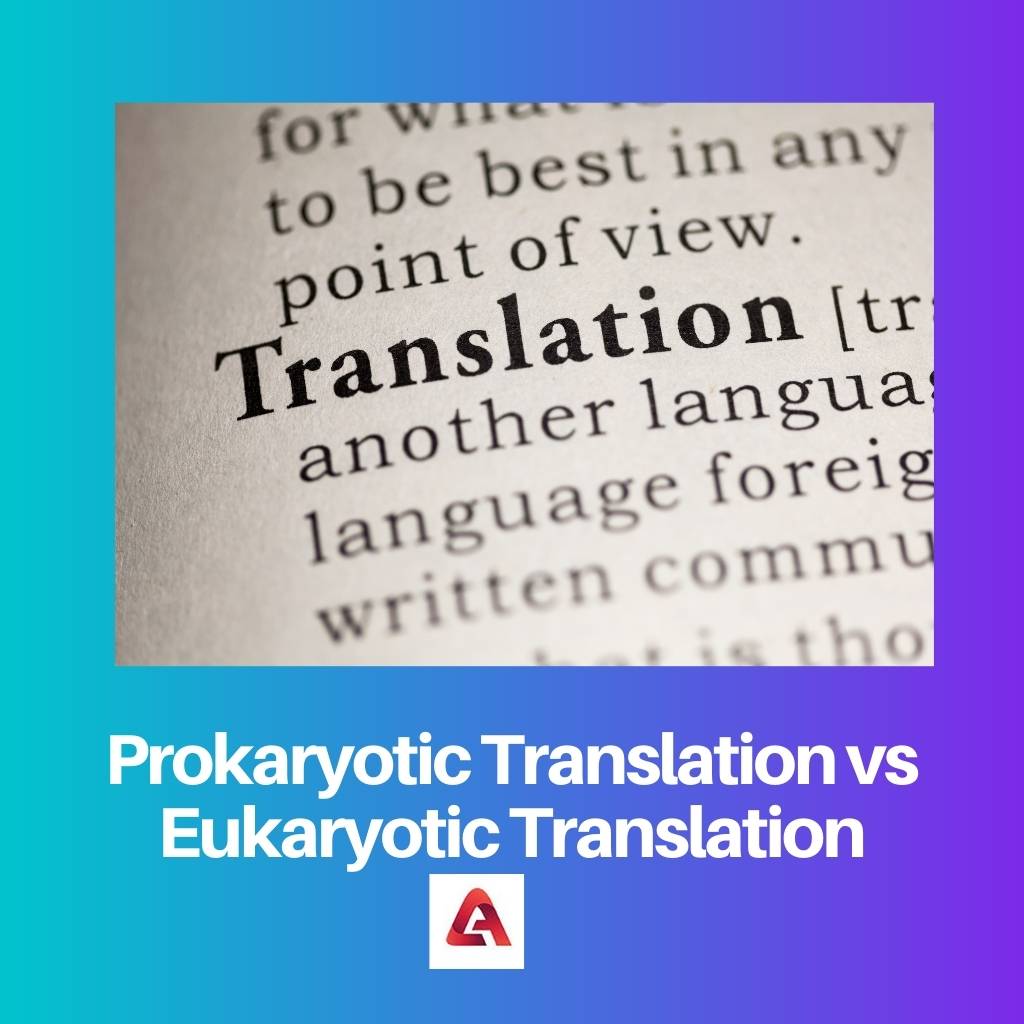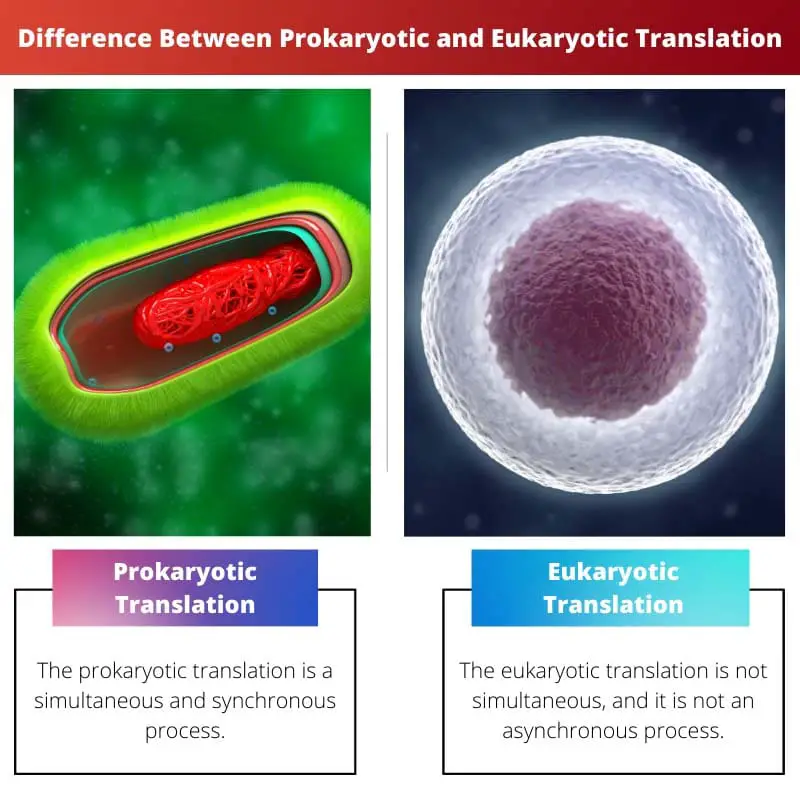The translation is a process of sequential translation of messenger RNA (mRNA) to a sequence of amino acids during protein synthesis. This process involves ribosomes in the cellular matrix.
Ribosomes present in the matrix component produce proteins after transcription of DNA to RNA conversion in the cell’s nucleus. This process is cumulatively referred to as gene expression.
Key Takeaways
- Prokaryotic translation occurs in the cytoplasm and is simpler and faster than eukaryotic translation, which occurs in the cytoplasm and on ribosomes attached to the endoplasmic reticulum.
- Prokaryotic mRNA is polycistronic, meaning it can encode multiple proteins, while eukaryotic mRNA is monocistronic, encoding only one protein per mRNA molecule.
- Transcriptional mechanisms regulate prokaryotic translation, while a variety of post-transcriptional mechanisms regulate eukaryotic translation.
Prokaryotic Translation vs Eukaryotic Translation
Prokaryotic translation is the process by which prokaryotic cells, such as bacteria, translate genetic information from mRNA to protein. The eukaryotic translation is the process by which eukaryotic cells, such as animal and plant cells, translate genetic information from mRNA to protein.

Prokaryotic translation contains mRNAs that are present in the cytoplasm, whereas eukaryotic mRNAs are present in the nucleus of an organism.
The prokaryotic translation involves three steps, namely initiation, elongation, and termination. It is the process of protein synthesis by the information provided by mRNA.
The protein synthesis involves the enzyme aminoacyl transfer RNA synthase.
The eukaryotic translation is the systematic scheme of events that includes the tRNA. It is translated into protein in the eukaryotic organism.
This translation in eukaryotes is a four-step process and possesses four phases. The four phases include gene regulation, elongation, termination, and recycling.
It is a cyclic process in which ribosomal subunits are derived by cyclic recycling of post-termination ribosomal complexes.
Comparison Table
| Parameters of Comparison | Prokaryotic Translation | Eukaryotic Translation |
|---|---|---|
| Process type | The prokaryotic translation is a simultaneous and synchronous process. | The eukaryotic translation is not simultaneous, and it is not an asynchronous process. It is discontinuous in nature. |
| Steps involved | The steps involve initiation, elongation, and termination with release factors. | The steps rest on four phases, including gene regulation, elongation, termination, and recycling. |
| Ribosomal subunits | It occurs on 70S ribosomes comprising the 50S and 30S subunits. | It occurs on 80S ribosomes consisting of two subunits, the 60S and 40S subunits. |
| Nature of Process | It is a relatively faster process and adds up around 20 residues for protein synthesis per second. | It is slower, and it adds up around 9 residues maximum per second. |
| Initiation factors | There are three initiation factors involved: IF1, IF2-GTP, and IF3. | There are 12eIFs, i.e., eukaryotic initiation factors, involved in the synthesis. |
What is Prokaryotic Translation?
Prokaryotic translation occurs in the cytoplasm, and the ribosomal subunits are present in this locality. Two enzymes, aminoacyl tRNA synthetase, and peptidyl transferase, are involved in prokaryotic translation.
The protein synthesis in prokaryotic translation requires mRNA, tRNA, amino acids, and ribosomes, along with specific enzyme requirements. The IF1 factor is used in initiation to help to stabilize the 30S ribosomal subunit.
The elongation process helps in the translocation of ribosomes. The EF-TS and EF-G generate EF-TU.
The termination factors involve RF-1. RF-2 and RF-3. The RF-1 aids in segregating polypeptides from the transfer ribonucleic acid, and it is also specific for certain genetic codons.
The RF-2 helps to dissociate polypeptides specific for UGA and UAA. The RF-3 in the termination process stimulates RF-1 and RF-2.
The activation of amino acids takes place in the cytoplasm. The activation of amino acids is catalyzed by their enzyme aminoacyl tRNA synthetases.
The amino acid present in the transfer ribonucleic acid, while changing sites, forms a peptide bond.
Ribosomes are present as subunits. They aid in producing proteins.
There is certainly a lot of research being conducted to study the sub-unit formation and function. These subunits also form together as they are present as two individual components.
They can be found in the cellular matrix.
What is Eukaryotic Translation?
The eukaryotic translation is discontinuous and not a synchronizing process. This non-continuous process involves ribosomes that are present in the matrix of the cellular structure.
Proteins are synthesized after the completion of transcription. The prokaryotic ribosome contains three binding sites.
These sites are named the A, P, and E sites. These sites are the places where binding, transfer, and exit mechanism takes place.
Messenger RNAs located tend to be called monocistronic. The beginning of protein production in higher organisms requires those contributing factors to initiate the cell translation process.
The initiating amino acid is methionine, whereas prokaryotes require the amino acid N-formyl methionine.
Upon terminating the elongation process, it requires the release of eukaryotic release factors. These factors do recognize three termination codes.
The codons contain termination information code for the mechanism of termination of the process in the cell. Followed by termination, polypeptides are produced in the end by the cell.
Here eukaryotic translation possesses a complicated initiation process. Through the initiation process, the consecutive processes, including elongation and termination processes, remain quite the same.
The initiation factors in eukaryotic translations are bound to a special tag for the 5’ cap as well as the 5’ UTR. RNA helicases are also involved in translation.
These RNA helicases include DHX29 and Ded1/DDX3. The elongation requires eukaryotic elongation factors.
Main Differences Between Prokaryotic and Eukaryotic Translation
- Prokaryotic translation is a simultaneous process, whereas eukaryotic translation is not simultaneous, and it is a discontinuous process.
- In prokaryotic translation, the ribosomes involved are the 30S and 50S ribosomes. In contrast, eukaryotic translation involves the 40S and 60S ribosomes.
- The prokaryotic translation possesses cap-independent initiation. In contrast, eukaryotic translation requires cap-dependent and cap-independent initiation.
- Prokaryotes do not require a definite phase for translation to occur, whereas, in eukaryotes, the translation occurs in G1 and G2 phases in a cell cycle.
- Prokaryotes have a single release factor, whereas eukaryotes have double release factors.

The article’s breakdown of the roles of termination factors in both prokaryotic and eukaryotic translation was very enlightening. It truly provides a comprehensive understanding of this complex process.
The article’s comprehensive explanation of termination factors and their significance in translation is truly impressive. A great resource indeed.
I couldn’t agree more! The article’s detailed analysis of termination factors has been immensely beneficial for understanding these processes.
The step-by-step breakdown of eukaryotic translation was incredibly insightful. I have gained a deeper appreciation for the complexity of this process after reading this article.
Absolutely, the article’s detailed content has been a valuable resource for understanding eukaryotic translation.
I really appreciate the detailed information provided about prokaryotic translation and the role of the termination factors. It provides a comprehensive view of the entire process.
Couldn’t agree more! The in-depth look at the process of termination in prokaryotic translation was particularly insightful.
Very true, the article does an exceptional job of breaking down the finer details of translation in both prokaryotic and eukaryotic organisms.
The explanations of the initiation, elongation, and termination stages of both prokaryotic and eukaryotic translation were very enlightening. It really adds depth to the understanding of this complex process.
The article’s clarity in distinguishing between prokaryotic and eukaryotic translation is truly commendable. It’s not we find such comprehensive information in one place.
Definitely. I appreciate how the article dives into the mechanics involved in each stage.
The comparison table adds great value to this article. It succinctly captures the disparities between prokaryotic and eukaryotic translation, making it easier to grasp the complexities of both processes.
I couldn’t agree more. This article provides an excellent reference for anyone seeking a comprehensive understanding of translation in different cell types.
The article’s in-depth review of prokaryotic translation and the role of ribosomes has been very educational. It has certainly expanded my knowledge on this topic.
Absolutely, the article’s depth of coverage on ribosomes and their role in prokaryotic translation is exceptional.
Couldn’t agree more. The coverage of such intricate processes in this article is truly commendable.
The comparison of ribosomal subunits and the nature of the translation process in prokaryotes and eukaryotes has been explained with great clarity. Kudos to the author for this informative piece!
I couldn’t agree more. The article’s detailed explanations have really enhanced my understanding of this topic.
Thanks for this informative article! It really breaks down the differences between prokaryotic and eukaryotic translation in a clear and concise manner.
I couldn’t agree more! The comparison table at the end is particularly helpful.
The detailed explanations of initiation factors in both prokaryotic and eukaryotic translation were very insightful. It really provides a comprehensive view of the entire translation process.
Absolutely! The article’s depth of coverage on such molecular mechanisms is truly impressive.
The thorough description of initiation factors and the differences between prokaryotic and eukaryotic translation is commendable. This brings a lot of clarity to the subject.
The breakdown of the differences in ribosomal subunits and initiation factors between prokaryotic and eukaryotic translation is the highlight of this article for me. Very well done!
Absolutely! It’s refreshing to come across such articulate and thorough content on complex biological processes.